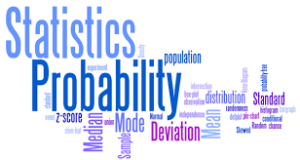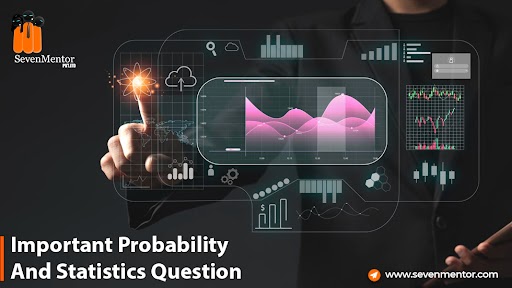Important Probability and Statistics Question…
In today’s data-driven world, the ability to analyze and interpret data is crucial across various industries. Therefore, it comes as no surprise that statistical and probability knowledge is highly sought after in job interviews, especially for roles in data analysis, data science, finance, and research. To help you ace your next interview, this blog will delve into some of the most common and challenging interview questions related to statistics and probability, along with detailed explanations and strategies to approach them. Join SevenMentor to learn Data Analytics Classes in Pune. It is a professional course that will enable you to understand the Important Probability and Statistics Question…

- Basic Concepts:
- What is the difference between population and sample? In statistics, a population refers to the entire set of individuals or items that a researcher wishes to study. A sample, on the other hand, is a subset of the population used to draw conclusions about the entire group. Understanding this distinction is vital for designing and interpreting studies correctly.
- Define measures of central tendency (mean, median, mode). Measures of central tendency are used to describe the typical value in a dataset. The mean is the sum of all values divided by the total number of observations, the median is the middle value in a sorted dataset, and the mode is the value that occurs most frequently.
- What is the standard deviation? The standard deviation measures the amount of variation or dispersion in a dataset. It indicates how much individual data points differ from the mean. A smaller standard deviation suggests that the data points are close to the mean, while a larger one indicates greater variability.
For Free, Demo classes Call: 075074 14653
Registration Link: Click Here!
- Probability:
- Explain the concept of probability. Probability is a measure of the likelihood that an event will occur. It is expressed as a value between 0 and 1, where 0 indicates an impossible event, 1 denotes a certain event, and values in between represent varying degrees of possibility.
- What is the difference between independent and dependent events? Independent events are events in which the outcome of one event does not affect the outcome of another. In contrast, dependent events are events in which the outcome of one event influences the outcome of the other.
- Calculate the probability of rolling a fair six-sided die and getting an even number. Since there are three even numbers (2, 4, and 6) out of six possible outcomes, the probability of rolling an even number is 3/6 or 1/2.
- Hypothesis Testing:
- What is hypothesis testing? Hypothesis testing is a statistical method used to make inferences about a population based on sample data. It involves setting up two competing hypotheses, the null hypothesis (H0) and the alternative hypothesis (Ha), and using sample data to determine which hypothesis is more likely.
- Explain Type I and Type II errors. In hypothesis testing, a Type I error (false positive) occurs when we reject a true null hypothesis. A Type II error (false negative) occurs when we fail to reject a false null hypothesis.
- How do you choose the significance level (alpha) in hypothesis testing? The significance level, denoted as alpha (α), represents the probability of making a Type I error. Commonly used values for alpha are 0.05 and 0.01, but the choice depends on the level of risk one is willing to take.
- Probability Distributions:
- What is a normal distribution? A normal distribution, also known as a Gaussian distribution, is a symmetric bell-shaped curve that represents the probability distribution of a continuous random variable. It is characterized by its mean and standard deviation.
- Explain the central limit theorem. The central limit theorem states that the sampling distribution of the sample means approaches a normal distribution as the sample size increases, regardless of the shape of the population distribution. This theorem is fundamental in inferential statistics.
- What is the difference between a discrete and continuous random variable? A discrete random variable can only take on specific, separate values, often integers, while a continuous random variable can take any value within a certain range. For example, the number of children in a family is a discrete random variable, while height is a continuous random variable.
For Free, Demo classes Call: 075074 14653
Registration Link: Click Here!
- Regression Analysis:
- Define linear regression. Linear regression is a statistical method used to model the relationship between a dependent variable and one or more independent variables. It assumes a linear relationship between the variables and aims to find the best-fitting line through the data points.
- How do you interpret the coefficients in a linear regression equation? In a simple linear regression equation (y = mx + b), the coefficient (m) represents the change in the dependent variable (y) for a one-unit change in the independent variable (x). The intercept (b) represents the value of the dependent variable when the independent variable is zero.
- What is multicollinearity? Multicollinearity occurs when two or more independent variables in a regression model are highly correlated. This can lead to unstable and unreliable coefficient estimates, making it challenging to interpret the individual effects of each variable.
In today’s data-driven world, the ability to analyze and interpret data is crucial across various industries. Therefore, it comes as no surprise that statistical and probability knowledge is highly sought after in job interviews, especially for roles in data analysis, data science, finance, and research. To help you ace your next interview, this blog will delve into some of the most common and challenging interview questions related to statistics and probability, along with detailed explanations and strategies to approach them.
For Free, Demo classes Call: 075074 14653
Registration Link: Click Here!
- Basic Concepts:
- What is the difference between population and sample? In statistics, a population refers to the entire set of individuals or items that a researcher wishes to study. A sample, on the other hand, is a subset of the population used to draw conclusions about the entire group. Understanding this distinction is vital for designing and interpreting studies correctly.
- Define measures of central tendency (mean, median, mode). Measures of central tendency are used to describe the typical value in a dataset. The mean is the sum of all values divided by the total number of observations, the median is the middle value in a sorted dataset, and the mode is the value that occurs most frequently.
- What is the standard deviation? The standard deviation measures the amount of variation or dispersion in a dataset. It indicates how much individual data points differ from the mean. A smaller standard deviation suggests that the data points are close to the mean, while a larger one indicates greater variability.
Conclusion:
Statistics and probability are integral parts of data analysis and decision-making in various professional fields. Being well-versed in these concepts can significantly enhance your chances of landing a competitive job in today’s data-centric job market. By thoroughly understanding the foundational concepts, probability theory, hypothesis testing, probability distributions, and regression analysis, you’ll be better equipped to tackle interview questions and demonstrate your analytical skills to potential employers. Stay curious, practice regularly, and always be prepared to showcase your statistical prowess during your next interview. Learn data visualization, statistical analysis, and tools like Python and R from SevenMentor’s best Data Analytics Course in Pune. Start your journey to becoming a skilled data analyst today!
Do visit our channel to explore more: Click Here
Good luck!
Author:
Nishesh Gogia
Call the Trainer and Book your free demo Class For Data Analytics Call now!!!
| SevenMentor Pvt Ltd.
© Copyright 2021 | SevenMentor Pvt Ltd.

